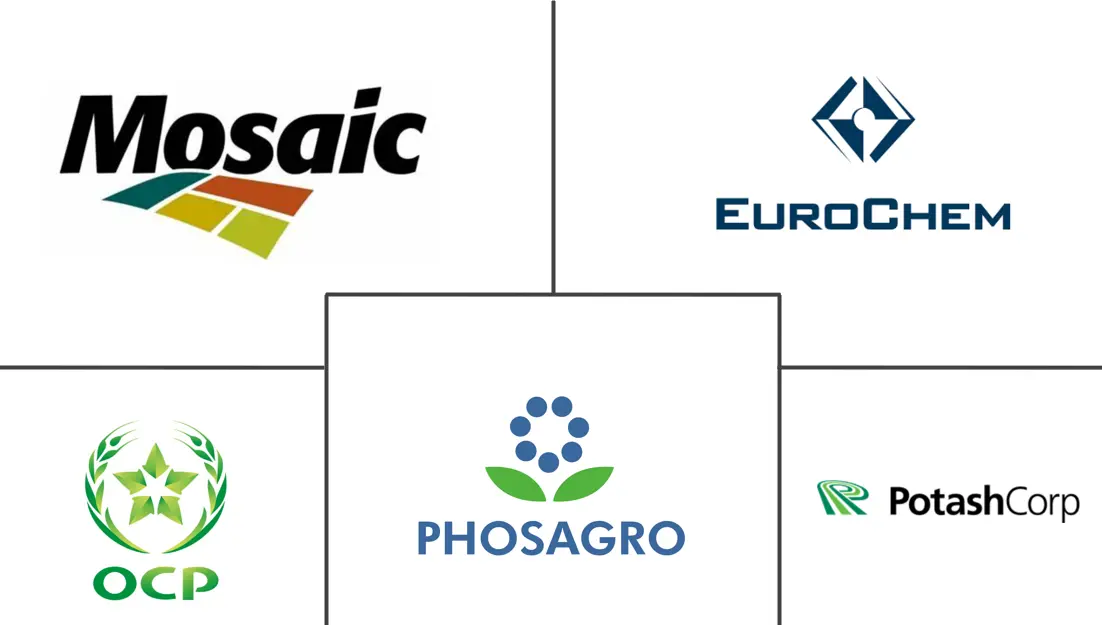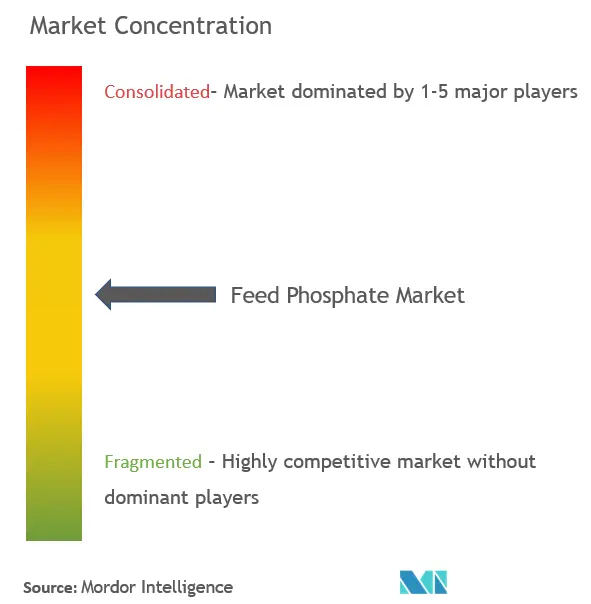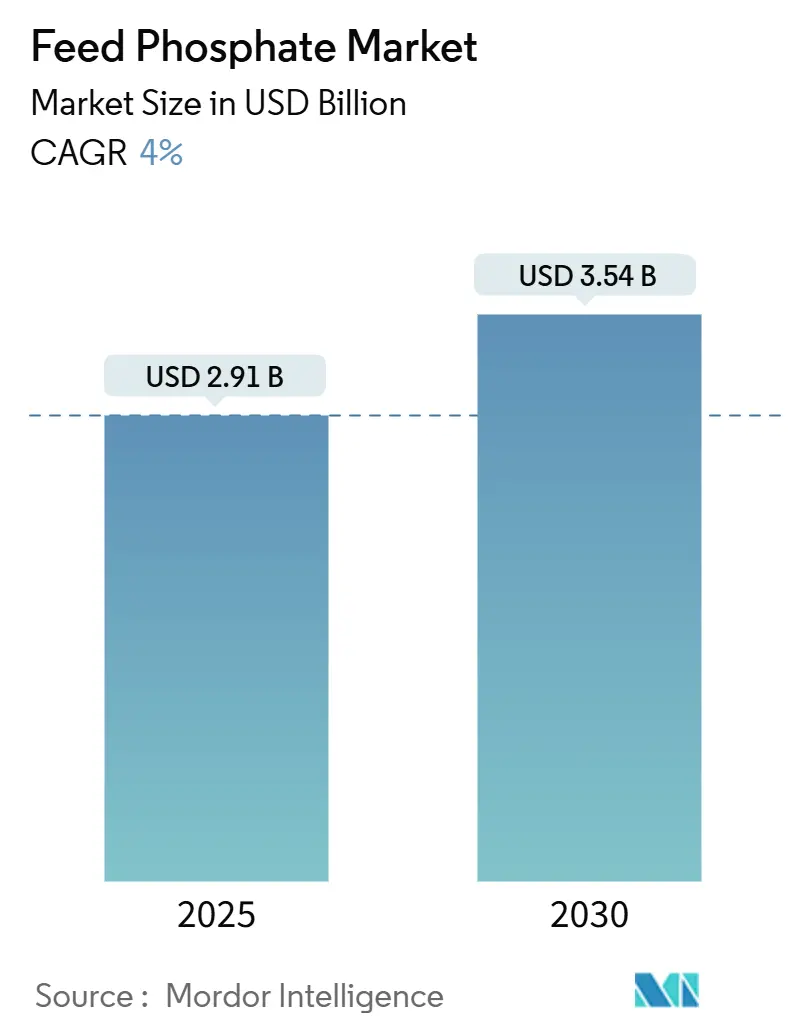
Feed Phosphate Market Analysis
The Feed Phosphate Market size is estimated at USD 2.91 billion in 2025, and is expected to reach USD 3.54 billion by 2030, at a CAGR of 4% during the forecast period (2025-2030).
- Global meat consumption is the primary driver of market growth. A report from the Organisation for Economic Co-operation and Development (OECD) projects that by 2030, poultry meat will account for 41% of all protein sourced from meat, a 2 percentage point increase from the base period. Global shares for other meat products include beef at 20%, pigmeat at 34%, and sheep meat at 5%.
- The growth in middle-class consumers with higher disposable incomes has increased meat consumption. The industrialization of the meat sector, particularly in poultry and pork, has strengthened the feed phosphate industry due to increased lean meat consumption driven by health awareness. However, rising raw material costs and the global depletion of phosphate reserves, a non-renewable resource, constrain market growth. The industry has responded with alternatives, such as incorporating phytase into animal feed blends to reduce manufacturing costs. Companies are investing in research and development for sustainable phosphate use. In 2022, Phosphea introduced HumIPHORA, a phosphate product that improves the utilization of plant-based phosphorus and reduces the need for conventional phosphate sources in feed formulas.
- The Asia-Pacific region, as the largest producer and consumer of animal feed, significantly influences the feed phosphates market. While the livestock sector in this region continues to industrialize, many farmers in India and China operate at marginal levels. Major economies in the region have expanded their feed production capabilities to support their growing livestock industries.
Feed Phosphate Market Trends
Increasing Industrial Livestock Production
- Significant supply-side transformations are occurring to meet the increasing demand for livestock products, with a focus on yield improvement. Industrial-scale production of poultry and pig meat has emerged through capital-intensive technologies across North America, Europe, and Asia-Pacific, particularly in regions with limited land resources. According to the Food and Agriculture Organisation (FAO), global meat production has increased during the study period. FAOSTAT data indicates that world poultry meat production was anticipated to reach 142 million tons (in carcass weight equivalent) in 2023, representing a 1% increase from 2022. The Asian market, primarily driven by China's pig meat production, along with South America's increased bovine and poultry meat output, was anticipated to contribute significantly to this growth. Production in other regions remained stable, with Europe's projected decline offsetting the overall increase.
- Consumer preferences are increasingly favoring poultry meat consumption. In developing countries with lower incomes, poultry is preferred due to its lower cost compared to other meat types. High-income countries show greater preference for white meats, considering their ease of preparation and perceived health benefits. Projections indicate that poultry meat will constitute 41% of all protein from meat sources globally by 2030. According to the United States Department of Agriculture (USDA) and World Agricultural Supply and Demand Estimates (WASDE), U.S. poultry meat consumption is projected to reach 117.6 pounds in 2024, a 1.5% increase from 2023. China leads global chicken consumption at 15,032 thousand metric tons, followed by Brazil at 10,280 thousand metric tons, and Canada at 1,411 thousand metric tons.
- Industrial-scale livestock production emphasizes high-quality feed utilization to enhance production efficiency, improve feed conversion ratios, and increase animal muscle mass and protein content. The growing adoption of industrial-scale livestock production necessitates increased production of feed additives to support the expanding demand for high-quality compound feed. This trend is anticipated to drive growth in the global feed additives market during the forecast period. The expansion in milk and cattle production continues to support market growth.
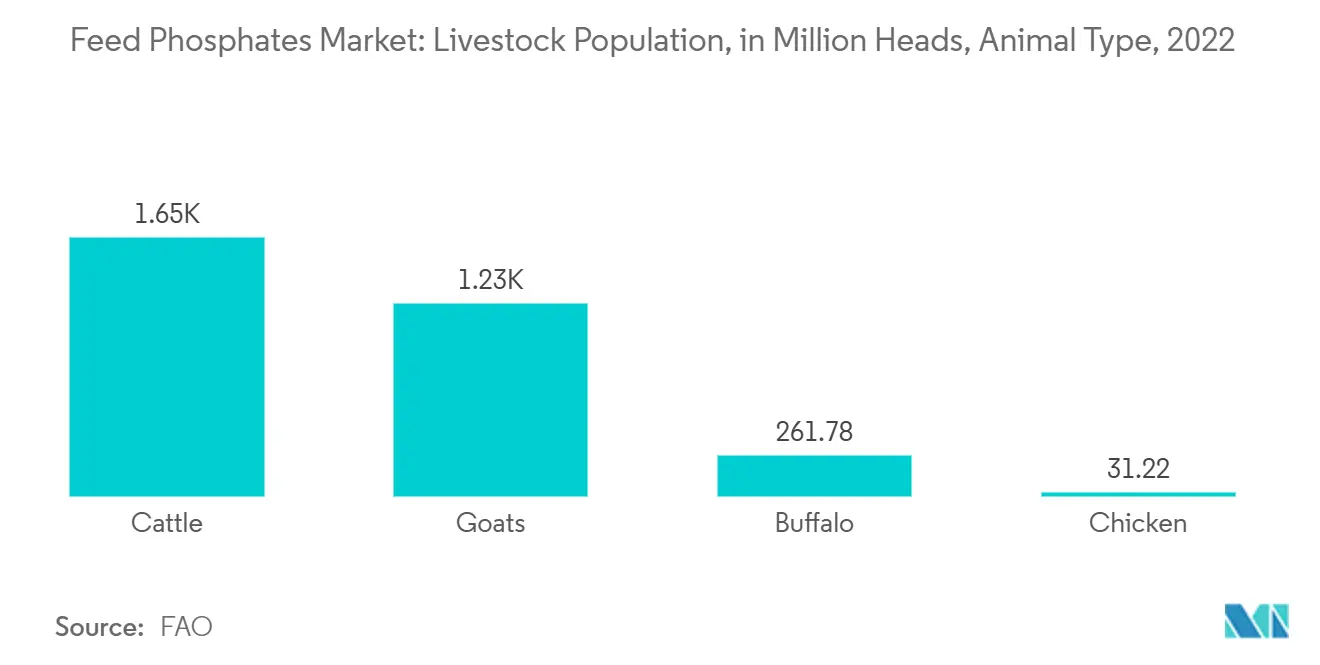
Asia-Pacific Dominates the Market
- With rapid economic growth, the demand potential for meat protein in Asia, especially in China, India, Malaysia, Vietnam, and Thailand, has been strong over the past years. This demand for meat protein has triggered meat production in the region, where uptake of compound feed has increased and is anticipated to show a higher growth rate. Apart from improving nutritional value, compound feed is gaining importance in improving meat quality.
- The compound feed industry in China has expanded tremendously over recent years. According to a survey by Alltech, the feed output in China has expanded significantly over the past years, making it one of the leading countries with a significant increase in feed production by tonnage. China is the leading country in feed production in the region, accounting for 262.71 million metric tons, followed by India, with 52.83 million metric tons during the year 2023.
- Moreover, over the past years, the trade of compound feed in the region has also, expanded. The increasing demand for beef exports in various countries is driving the production of compound feed in this segment. For instance, in 2023, carabeef exports from India reached 1.48 million metric tons, with a significant portion being exported to markets in Malaysia and the Middle East, as reported by USDA. This surge in exports underscores the need for efficient compound feed production to meet international market demands, in turn accelarating the demand for feed phosphate in the region.
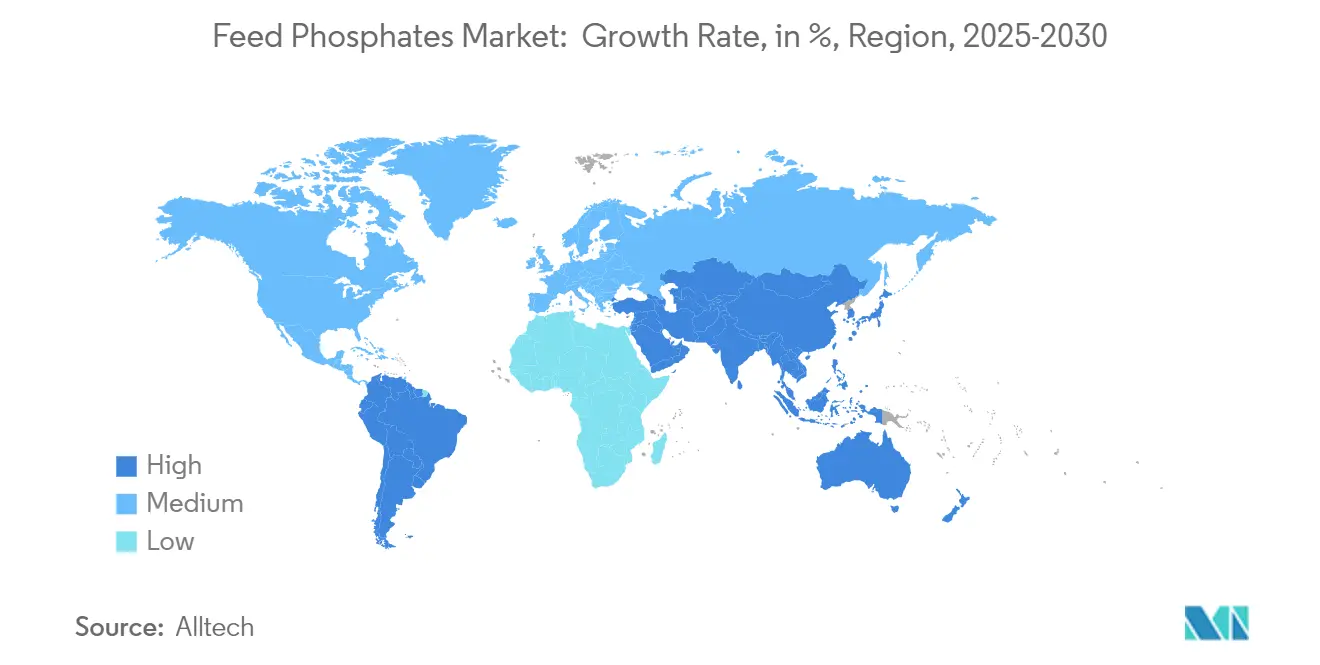
Feed Phosphate Industry Overview
The feed phosphate market is consolidated, with a few active players, including The Mosaic Company, Eurochem, Potash Corp, PhosAgro, and OCP Group, occupying a considerable market share in 2023. These companies focus on expanding their businesses and undertaking strategies like mergers and acquisitions, expansions, and novel product innovations. Leading companies focused on acquiring feed mills and small manufacturing to expand their business in local and foreign markets. These companies are focused on the expansion of the business across regions and setting up a new plant for increasing production capacity as well as a product line.
Feed Phosphate Market Leaders
-
The Mosaic Company
-
Eurochem
-
Phosagro
-
OCP Group
-
Potash Corporation
- *Disclaimer: Major Players sorted in no particular order
Feed Phosphate Market News
- May 2023: OCP Group acquired Global Feed S.L., a Spain-based manufacturer and distributor of animal nutrition products, including phosphate-based commodities and specialized feed solutions for various livestock species. The acquisition aims to increase Global Feed's production capacity to 400,000 metric tons per year by 2027 to meet global customer demand and expand its product portfolio.
- April 2022: PHOSPHEA announced the launch of HumIPHORA, a breakthrough innovation in the phosphate world. This calcium humophosphate is listed in the European Animal Feed Register (008979-EN). For the first time in the market, Phosphea offered a phosphate that provides high-quality phosphorus and contributes to better use of other nutrients, more specifically, plant-based phosphorus.
- February 2022: EuroChem Group completed the acquisition of the Serra do Salitre phosphate project in Brazil. This acquisition led to the increased development of phosphates, and it may increase the sales of animal feed phosphate in the coming years.
Feed Phosphate Industry Segmentation
Feed phosphates are added to animal feed to improve the nutrient content, optimize animal performance, and enhance feed digestibility and health maintenance. They also help promote growth during the various life cycle stages, develop fertility in animals, and act as the best calcium source for bone and skeleton development. The feed phosphate market is segmented by feed type (monocalcium phosphate, dicalcium phosphate, mono-dicalcium phosphate, tricalcium phosphate, defluorinated phosphate, and other feed types), livestock type (poultry, swine, cattle, aquatic animals, and other livestock types), and geography (North America, Europe, Asia-Pacific, South America, and Africa). The report offers market size and forecasts in value (USD) for all the above segments.
| Feed Type | Monocalcium Phosphate | ||
| Dicalcium Phosphate | |||
| Mono-Dicalcium Phosphate | |||
| Tricalcium Phosphate | |||
| Defluorinated Phosphate | |||
| Other Feed Types | |||
| Livestock Type | Poultry | ||
| Swine | |||
| Cattle | |||
| Aquatic Animals | |||
| Other Livestock Types | |||
| Geography | North America | United States | |
| Canada | |||
| Mexico | |||
| Rest of North America | |||
| Europe | Germany | ||
| United Kingdom | |||
| France | |||
| Russia | |||
| Spain | |||
| Rest of Europe | |||
| Asia-Pacific | India | ||
| China | |||
| Japan | |||
| Australia | |||
| Rest of Asia-Pacific | |||
| South America | Brazil | ||
| Argentina | |||
| Rest of South America | |||
| Africa | South Africa | ||
| Rest of Africa | |||
Feed Phosphate Market Research FAQs
How big is the Feed Phosphate Market?
The Feed Phosphate Market size is expected to reach USD 2.91 billion in 2025 and grow at a CAGR of 4% to reach USD 3.54 billion by 2030.
What is the current Feed Phosphate Market size?
In 2025, the Feed Phosphate Market size is expected to reach USD 2.91 billion.
Who are the key players in Feed Phosphate Market?
The Mosaic Company, Eurochem, Phosagro, OCP Group and Potash Corporation are the major companies operating in the Feed Phosphate Market.
Which is the fastest growing region in Feed Phosphate Market?
North America is estimated to grow at the highest CAGR over the forecast period (2025-2030).
Which region has the biggest share in Feed Phosphate Market?
In 2025, the Asia-Pacific accounts for the largest market share in Feed Phosphate Market.
What years does this Feed Phosphate Market cover, and what was the market size in 2024?
In 2024, the Feed Phosphate Market size was estimated at USD 2.79 billion. The report covers the Feed Phosphate Market historical market size for years: 2019, 2020, 2021, 2022, 2023 and 2024. The report also forecasts the Feed Phosphate Market size for years: 2025, 2026, 2027, 2028, 2029 and 2030.
Our Best Selling Reports
Feed Phosphate Industry Report
Statistics for the 2025 Feed Phosphate market share, size and revenue growth rate, created by Mordor Intelligence™ Industry Reports. Feed Phosphate analysis includes a market forecast outlook for 2025 to 2030 and historical overview. Get a sample of this industry analysis as a free report PDF download.

